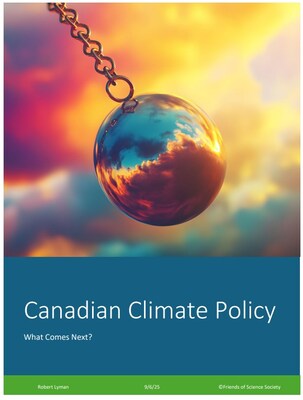“Canadian Climate Policy – What Comes Next?” is a new report by Robert Lyman, published by Friends of Science Society. US Endangerment Finding on carbon dioxide is consequential to central bank and Canadian climate policies.
CALGARY, AB, Sept. 12, 2025 /PRNewswire/ — Friends of Science Society’s new report titled, “Canadian Climate Policy – What Comes Next?” offers key points on Canada’s climate commitments as published in: Canada’s First Biennial Transparency Report under the Paris Agreement and Canada’s 2035 Nationally Determined Contribution (NDC). Authored by retired energy economist, Robert Lyman, the Friends of Science Society report shows that Canada’s GHG reduction aspirations are not backed up by any means of how to achieve targets.
Canadian Climate Policy – What Comes Next? Image licensed from Adobe Stock.
Friends of Science Society produced a video explainer of the “Canadian Climate Policy…” report, noting that instead of predicting future climate damages, the Canadian government reports now tie present day wildfires and extreme weather events to climate change; this conflation is not supported by the findings of the Intergovernmental Panel on Climate Change (IPCC).
Lyman writes that climate policies must be “made more realistic… At a minimum, that requires more transparency as to how the new targets will be met. Even better would be to abandon targets altogether.”
As reported by the CBC on Sept. 11, 2025, newly minted Prime Minister Mark Carney announced five Canadian “nation-building” projects, many of which may stimulate the economy, but are not “climate friendly” and do not align with Canada’s Paris Agreement climate targets, says Friends of Science Society.
Within two hours of the Carney major projects announcement, a group of Indigenous and Environmental Non-governmental Organizations (ENGO) rejected the approval of the expansion LNG Canada Phase 2, calling it a “carbon bomb,” as reported by the National Observer, bogging down economic development, says Friends of Science Society.
National Observer is part of the media umbrella group, “Covering Climate Now,” which is about to relaunch its “89% Project.” This is a bandwagoning media campaign to encourage the public to demand more climate action. This is advocacy, not journalism, says Friends of Science Society in this video critiquing the campaign.
The astounding “carbon bomb” claims of “climate damages” by these ENGOs in the National Observer article are based on a study by Clean Energy Canada which references Environment and Climate Change Canada as the source for its Social Cost of Carbon damages, which in turn are said to be “identical” to those adopted by the US EPA.
Story Continues
